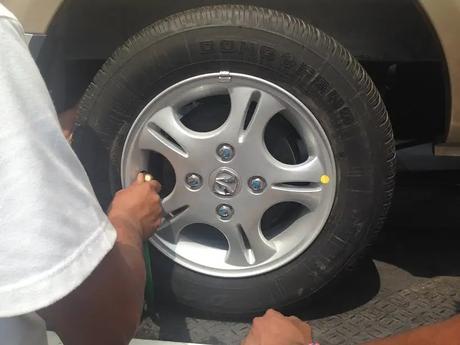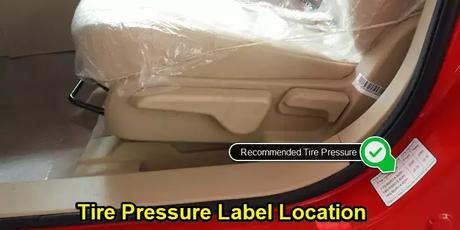
When it comes to vehicle safety, one crucial yet often overlooked aspect is tire pressure. Proper tire pressure is essential for safe driving, and every car is equipped with a tire pressure label that provides important information regarding the recommended tire pressure levels. Here's why checking your car's tire pressure label is crucial for safe driving:
Optimal Performance: Maintaining the correct tire pressure as indicated on your car's tire pressure label ensures that your tires perform at their best. Underinflated or overinflated tires can affect your car's handling, traction, and braking performance, increasing the risk of accidents, especially in adverse weather conditions.

Extended Tire Lifespan: Proper tire pressure helps extend the lifespan of your tires. Underinflated tires wear out faster and unevenly, leading to premature tire replacement and increased costs. On the other hand, overinflated tires can result in a harsh ride and reduced traction. Checking your car's tire pressure label and maintaining the recommended levels can help you get the most out of your tires, saving you money in the long run.
Fuel Efficiency: Properly inflated tires can also improve your car's fuel efficiency. Underinflated tires create more rolling resistance, which requires your engine to work harder and consume more fuel. By keeping your tires inflated to the recommended levels, as indicated on your car's tire pressure label, you can help improve your gas mileage and save on fuel costs.
Safety on the Road: Ensuring that your tires are properly inflated, as per the recommended levels on your car's tire pressure label, is crucial for safe driving. Properly inflated tires provide better grip, stability, and control, reducing the risk of accidents caused by tire-related issues such as blowouts, skidding, or loss of control.
Easy and Convenient: Checking your car's tire pressure is a simple and quick task that can be done regularly to ensure optimal tire performance. Most vehicles have the recommended tire pressure levels listed on a label, usually located on the driver's side door jamb, glove compartment, or in the owner's manual. It's easy to access this information and maintain the proper tire pressure with regular checks.
In conclusion, checking your car's tire pressure label and maintaining the recommended levels is crucial for safe driving, optimal tire performance, extended tire lifespan, improved fuel efficiency, and overall road safety. Make it a habit to regularly check your tire pressure and inflate your tires as needed to ensure a smooth, safe, and efficient driving experience. Remember, proper tire pressure is a small investment that pays off in terms of safety, performance, and savings in the long run.
What should be tire pressure?
The recommended tire pressure for your vehicle can typically be found in your owner's manual or on a sticker located on the driver's side door jamb. It's important to follow the manufacturer's recommended tire pressure, as this helps ensure optimal handling, fuel efficiency, and tire life.The tire pressure can vary depending on factors such as the vehicle's weight, load capacity, and tire size, so it's important to use the correct values. Generally, tire pressure is measured in pounds per square inch (psi), and the recommended pressure can range from around 30 to 40 psi.
It's also important to regularly check your tire pressure, as it can decrease over time due to factors such as temperature changes and normal wear and tear. A tire pressure gauge can be used to measure the pressure, and air can be added as needed at a service station or with a portable air compressor.
What tire pressure is too low
Tire pressure that is too low can cause a number of problems, including reduced fuel efficiency, poor handling, and premature wear and tear on your tires. If your tire pressure is too low, your tires will also be more susceptible to damage from potholes, curbs, and other hazards on the road.The exact tire pressure that is considered too low will depend on the recommended tire pressure for your vehicle. In general, if your tire pressure is more than 20% below the recommended level, it is considered too low. For example, if the recommended tire pressure for your vehicle is 32 psi, then a tire pressure of 25.6 psi or lower would be considered too low.
It's important to regularly check your tire pressure using a tire pressure gauge to ensure that your tires are properly inflated and to prevent problems associated with low tire pressure. If you notice that your tire pressure is consistently low, you should have your tires inspected by a professional to check for any leaks or other issues that may be causing the problem.
Do you want more videos about auto repair?
Subscribe to our Cartechhome Channel on Youtube
Help us expand the people we help by sharing this information with others. Thank you !!!
